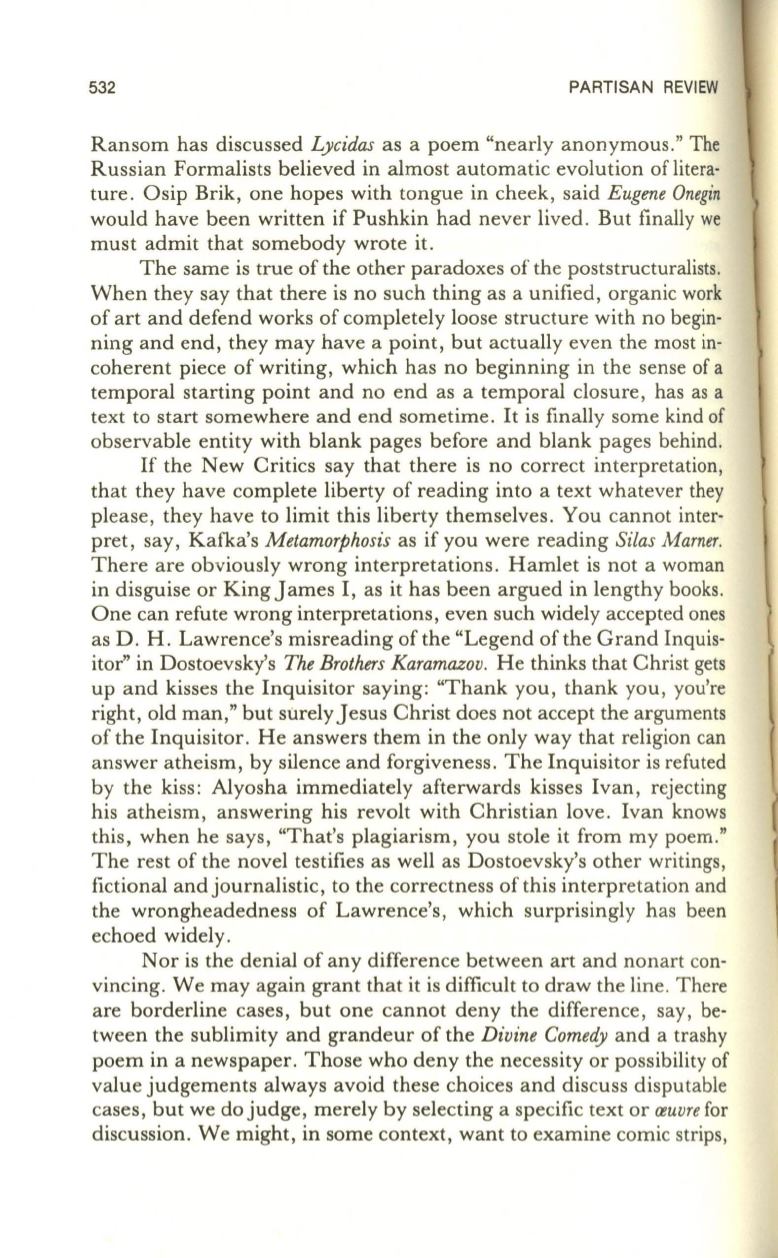
532
PARTISAN REVIEW
Ransom has discussed
Lycidas
as a poem "nearly anonymous." The
Russian Formalists believed in almost automatic evolution of litera–
ture. Osip Brik, one hopes with tongue in cheek, said
Eugene Onegin
would have been written if Pushkin had never lived . But finally we
must admit that somebody wrote it.
The same is true of the other paradoxes of the poststructuralists.
When they say that there is no such thing as a unified, organic work
of art and defend works of completely loose structure with no begin–
ning and end, they may have a point, but actually even the most in–
coherent piece of writing, which has no beginning in the sense of a
temporal starting point and no end as a temporal closure , has as a
text to start somewhere and end sometime.
It
is finally some kind of
observable entity with blank pages before and blank pages behind.
If
the New Critics say that there is no correct interpretation,
that they have complete liberty of reading into a text whatever they
please , they have to limit this liberty themselves. You cannot inter–
pret, say, Kafka's
Metamorphosis
as if you were reading
Silas Marner.
There are obviously wrong interpretations . Hamlet is not a woman
in disguise or King James I, as it has been argued in lengthy books.
One can refute wrong interpretations, even such widely accepted ones
as D. H. Lawrence's misreading of the "Legend of the Grand Inquis–
itor" in Dostoevsky's
The Brothers Karamazov.
He thinks that Christ gets
up and kisses the Inquisitor saying: "Thank you, thank you , you're
right, old man," but surely Jesus Christ does not accept the arguments
of the Inquisitor. He answers them in the only way that religion can
answer atheism, by silence and forgiveness. The Inquisitor is refuted
by the kiss: Alyosha immediately afterwards kisses Ivan, rejecting
his atheism, answering his revolt with Christian love. Ivan knows
this, when he says, "That's plagiarism, you stole it from my poem."
The rest of the novel testifies as well as Dostoevsky's other writings,
fictional and journalistic, to the correctness of this interpretation and
the wrongheadedness of Lawrence's, which surprisingly has been
echoed widely.
Nor is the denial of any difference between art and nonart con–
vincing. We may again grant that it is difficult to draw the line. There
are borderline cases, but one cannot deny the difference, say, be–
tween the sublimity and grandeur of the
Divine Comedy
and a trashy
poem in a newspaper. Those who deny the necessity or possibility of
value judgements always avoid these choices and discuss disputable
cases, but we do judge, merely by selecting a specific text or
reuvre
for
discussion. We might, in some context, want to examine comic strips,


